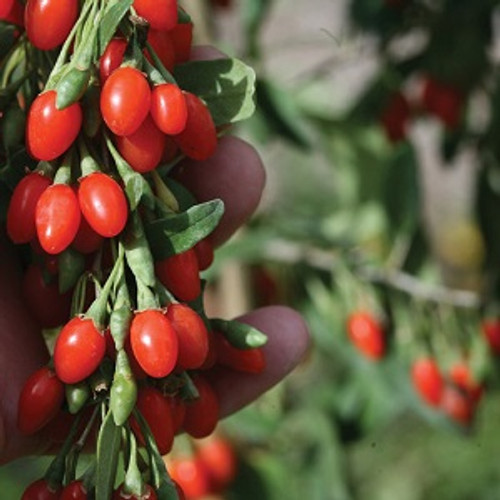| Lycium barbarum 'Firecracker' |
USDA Zone: 5-9 |
Firecracker Goji Berry is a medium-sized shrub that is commonly grown for its edible qualities, although it does have ornamental merits as well. It produces red oblong berries which are usually ready for picking from mid summer to early fall. The berries have a sweet taste.
Firecracker Goji Berry is draped in stunning deep purple flowers along the branches from late spring to early summer. It has green deciduous foliage. The narrow leaves do not develop any appreciable fall colour. It features an abundance of magnificent red berries from mid summer to mid fall. The fruit can be messy if allowed to drop on the lawn or walkways, and may require occasional clean-up.
A sprawling, vine-like shrub presenting deep purple flowers in late spring; grown for its prolific, highly nutritious and flavorful bright red berries that ripen earlier than other varieties; a bright, sunny location is best.
The berries are most often used in the following ways:
- Fresh Eating
- Cooking
- Preserves
Attracts Birds
Thornless or nearly thornless
Bloom Time: Summer
Common Name: Goji Berry
|
Key Feature
|
Light Needs | Landscape Uses |
 |
 |
|
|
|
|
| More About Firecracker Goji Berry |
| Height: 6 ft |
Spread: 6-8 ft |
Flower Colour: Purple Shades |
|
Firecracker Goji Berry is quite ornamental as well as edible, and is as much at home in a landscape or flower garden as it is in a designated edibles garden. It does best in full sun to partial shade. It does best in average to evenly moist conditions, but will not tolerate standing water. It is not particular as to soil type or pH. It is highly tolerant of urban pollution and will even thrive in inner city environments. Firecracker Goji Berry is a good choice for the edible garden, but it is also well-suited for use in outdoor pots and containers. With its upright habit of growth, it is best suited for use as a 'thriller' in the 'spiller-thriller-filler' container combination; plant it near the center of the pot, surrounded by smaller plants and those that spill over the edges. It is even sizeable enough that it can be grown alone in a suitable container. Note that when grown in a container, it may not perform exactly as indicated on the tag - this is to be expected. Also note that when growing plants in outdoor containers and baskets, they may require more frequent waterings than they would in the yard or garden. Be aware that in our climate, most plants cannot be expected to survive the winter if left in containers outdoors, and this plant is no exception. NOTE: Some flowers and plants may be harmful or poisonous to people or pets if touched or ingested. If you require more information before placing an order, please let us know in advance. |









